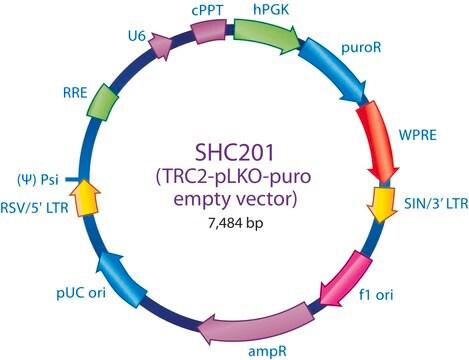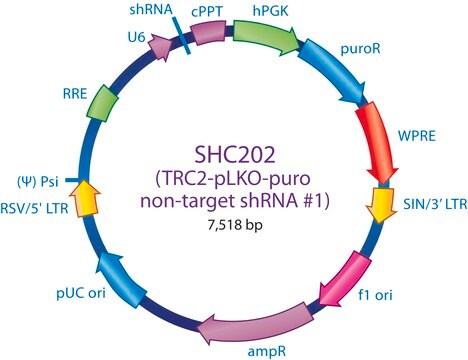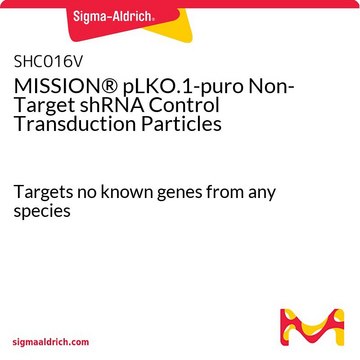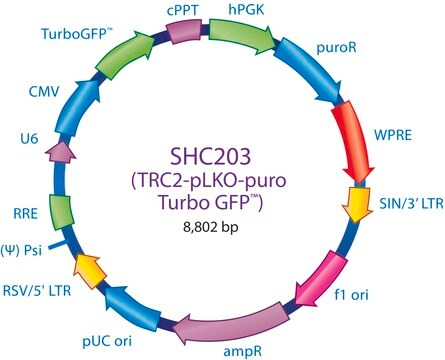SHC202V
MISSION® TRC2 pLKO.5-puro Non-Mammalian shRNA Control Transduction Particles
Targets no known mammalian genes
Sinonimo/i:
MISSION®, MISSION® Control Transduction Particles
Autenticatiper visualizzare i prezzi riservati alla tua organizzazione & contrattuali
About This Item
Codice UNSPSC:
41106609
NACRES:
NA.51
Prodotti consigliati
Livello qualitativo
Nome Commerciale
MISSION®
Concentrazione
≥1x106 VP/ml (via p24 assay)
Condizioni di spedizione
dry ice
Temperatura di conservazione
−70°C
Cerchi prodotti simili? Visita Guida al confronto tra prodotti
Categorie correlate
Descrizione generale
This shRNA non-mammalian control was designed using our Turbo GFP sequence and may cause some knockdown of tGFP. For maximum knockdown of tGFP, please refer to SHC004, SHC004V, SHC004H, SHC204, or SHC204V.
The MISSION TRC2 pLKO-puro Non-Target shRNA Control Transduction Particles are produced from the sequence-verified lentiviral plasmid, TRC2 pLKO-puro Non-Target shRNA (SHC202). This vector is in the TRC2 pLKO-puro plasmid backbone, which contains the WPRE. The vector contains an shRNA insert that does not target human or mouse genes, making it useful as a negative control in experiments using the MISSION TRC2 shRNA library clones.
Unlike murine-based MMLV or MSCV retroviral systems, lentiviral-based particles permit efficient infection and integration of the construct into differentiated and non-dividing cells, such as neurons and dendritic cells, overcoming low transfection and integration difficulties when using these cell lines. Self-inactivating replication incompetent viral particles are produced in packaging cells (HEK293T) by co-transfection with compatible packaging plasmids.
In addition, the lentiviral transduction particles are pseudotyped with an envelope G glycoprotein from Vesicular Stomatitis Virus (VSV-G), allowing transduction of a wide variety of mammalian cells. 200 μl of 106 TU/ml (via p24 titering assay) lentiviral particles are provided as frozen stock.
When conducting experiments using MISSION shRNA clones, the proper controls should be a key element of your experimental design to allow for accurate interpretation of knockdown results.
The MISSION TRC2 pLKO-puro Non-Target shRNA Control Transduction Particles are produced from the sequence-verified lentiviral plasmid, TRC2 pLKO-puro Non-Target shRNA (SHC202). This vector is in the TRC2 pLKO-puro plasmid backbone, which contains the WPRE. The vector contains an shRNA insert that does not target human or mouse genes, making it useful as a negative control in experiments using the MISSION TRC2 shRNA library clones.
Unlike murine-based MMLV or MSCV retroviral systems, lentiviral-based particles permit efficient infection and integration of the construct into differentiated and non-dividing cells, such as neurons and dendritic cells, overcoming low transfection and integration difficulties when using these cell lines. Self-inactivating replication incompetent viral particles are produced in packaging cells (HEK293T) by co-transfection with compatible packaging plasmids.
In addition, the lentiviral transduction particles are pseudotyped with an envelope G glycoprotein from Vesicular Stomatitis Virus (VSV-G), allowing transduction of a wide variety of mammalian cells. 200 μl of 106 TU/ml (via p24 titering assay) lentiviral particles are provided as frozen stock.
When conducting experiments using MISSION shRNA clones, the proper controls should be a key element of your experimental design to allow for accurate interpretation of knockdown results.
When conducting experiments using MISSION® shRNA clones, the proper controls should be a key element of your experimental design to allow for accurate interpretation of knockdown results. The MISSION Control Transduction Particles are a critical positive control to monitor transduction efficiency.
To see more application data, protocols, vector maps visit sigma.com/shrna.
To see more application data, protocols, vector maps visit sigma.com/shrna.
Applicazioni
Small interfering RNAs (siRNAs) expressed from short hairpin RNAs (shRNAs) are a powerful way to mediate gene specific RNA interference (RNAi) in mammalian cells. The MISSION product line is based on a viral vector-based RNAi library against annotated mouse and human genes. shRNAs that generate siRNAs intracellularly are expressed from amphotropic lentivirus viral particles, allowing screening in a wide range of mammalian cell lines. In these cell lines, MISSION shRNA clones permit rapid, cost efficient loss-of-function and genetic interaction screens.
To see more application data, protocols, vector maps visit sigma.com/shrna.
Note legali
MISSION is a registered trademark of Merck KGaA, Darmstadt, Germany
Raccomandato
N° Catalogo
Descrizione
Determinazione del prezzo
Codice della classe di stoccaggio
12 - Non Combustible Liquids
Classe di pericolosità dell'acqua (WGK)
WGK 3
Punto d’infiammabilità (°F)
Not applicable
Punto d’infiammabilità (°C)
Not applicable
Certificati d'analisi (COA)
Cerca il Certificati d'analisi (COA) digitando il numero di lotto/batch corrispondente. I numeri di lotto o di batch sono stampati sull'etichetta dei prodotti dopo la parola ‘Lotto’ o ‘Batch’.
Possiedi già questo prodotto?
I documenti relativi ai prodotti acquistati recentemente sono disponibili nell’Archivio dei documenti.
I clienti hanno visto anche
Anaïs Pujals et al.
Autophagy, 11(12), 2275-2287 (2015-11-14)
The Epstein-Barr virus (EBV) is associated with various lymphoproliferative disorders and lymphomas. We have previously demonstrated that treating wild-type TP53-expressing B cell lines with the TP53 pathway activator nutlin-3 induced apoptosis in EBV-negative and EBV-positive latency I cells whereas EBV-positive
Mariano J Alvarez et al.
Nature genetics, 50(7), 979-989 (2018-06-20)
We introduce and validate a new precision oncology framework for the systematic prioritization of drugs targeting mechanistic tumor dependencies in individual patients. Compounds are prioritized on the basis of their ability to invert the concerted activity of master regulator proteins
J E Donello et al.
Journal of virology, 72(6), 5085-5092 (1998-05-30)
The hepatitis B virus posttranscriptional regulatory element (HBVPRE) is a cis-acting RNA element that partially overlaps with enhancer I and is required for the cytoplasmic accumulation of HBV surface RNAs. We find that the closely related woodchuck hepatitis virus (WHV)
R Zufferey et al.
Journal of virology, 73(4), 2886-2892 (1999-03-12)
The expression of genes delivered by retroviral vectors is often inefficient, a potential obstacle for their widespread use in human gene therapy. Here, we explored the possibility that the posttranscriptional regulatory element of woodchuck hepatitis virus (WPRE) might help resolve
Enhancement of the acrolein-induced production of reactive oxygen species and lung injury by GADD34.
Yang Sun et al.
Oxidative medicine and cellular longevity, 2015, 170309-170309 (2015-03-31)
Chronic obstructive pulmonary disease (COPD) is characterized by lung destruction and inflammation. As a major compound of cigarette smoke, acrolein plays a critical role in the induction of respiratory diseases. GADD34 is known as a growth arrest and DNA damage-related
Il team dei nostri ricercatori vanta grande esperienza in tutte le aree della ricerca quali Life Science, scienza dei materiali, sintesi chimica, cromatografia, discipline analitiche, ecc..
Contatta l'Assistenza Tecnica.









